I continue to discover new (or rather, forgotten) stories of old Covina in my searches of online newspaper archives. This one I found especially fascinating. It tells of how Covina's first historian, on the verge of completing a book on her decade of research, was subsequently written out of the history books herself...
Published in 1964, Covina: Sunflowers, Citrus, Subdivisions by Donald H. Pflueger1 is still regarded as the definitive scholarly treatment of the city's history. In the book's introduction, Pflueger cites long-time Covina resident Gladys Ratekin as a primary source; in so doing intimating that she was the early town's principal chronicler. I have only recently learned, however, that such was not the case. Another woman who preceded Ratekin–Harriett Russell Head–was in actuality the first to garner local recognition and praise for her years-long efforts to document Covina's past.
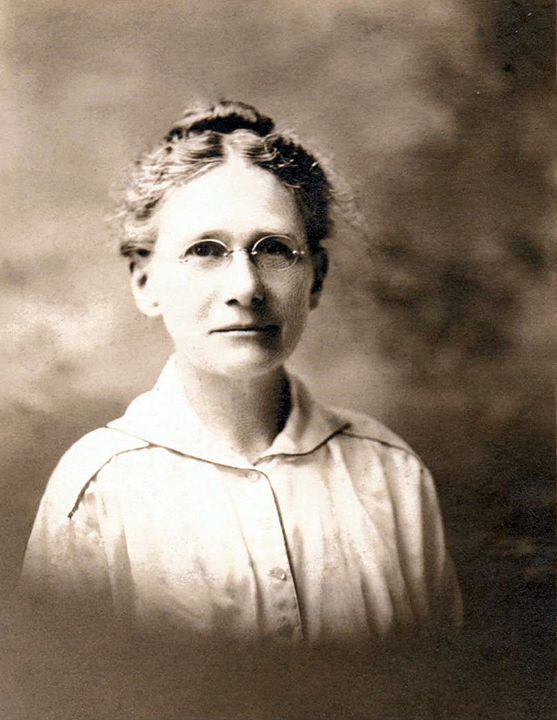
Harriett R. Head (1860-1936): Covina's first lady of history.
Photo courtesy Mr. Larry Head.
I became aware of Mrs. Head's work only incidentally while attempting to research Gladys Ratekin. I was curious if the latter had written any articles about early Covina for the town newspapers. I was dismayed to find none, and moreover, apparently only once during her lifetime was Miss Ratekin mentioned in the local press as having anything to do with Covina history. This is that single instance:
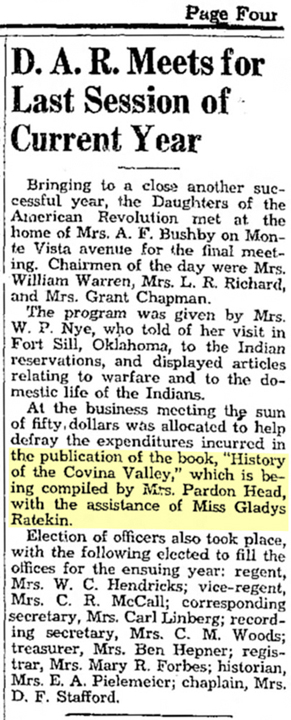
Covina Citizen, June 7, 1935.2
So, Gladys Ratekin had actually been someone else's understudy? And who was "Mrs. Pardon Head?" I could not recall seeing that name before. So I did another search. I was amazed to find a dozen detailed scholarly articles on Covina history, and an even greater number of news items which reported on Head's curation efforts. Perhaps understandably, this revelation came as quite a surprise.
One search result in particular attracted my attention. In this newspaper article, published in 1952 at the very beginning of his Covina project, Donald Pflueger revealed that he was indeed aware of Harriett Head...
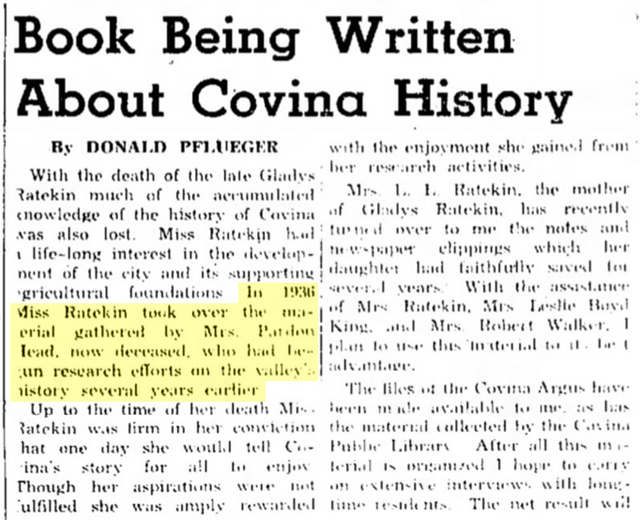
Covina Argus-Citizen, September 26, 1952.3
...and yet nowhere in his completed book is there any mention of Mrs. Head or her extensive prior work.
How extensive? See for yourself below.
But first, a thumbnail biography.
From a golden wedding anniversary announcement in the Covina Citizen, February 26, 1931:
Mr. and Mrs. Head were married in Dillon, Iowa, February 23, 1881. [...] Mrs. Head, who was Harriett Russell before her marriage, was born near Dubuque, Iowa, on October 9, 1860 [...]. Following their marriage, Mr. and Mrs. Head moved [...] to the farm [in Iowa] on which they lived and raised their children until 1917 when they came to Covina. [...] Mrs. Head has been very active in Covina club life, being a member of the D.A.R. and the Woman's club, in which she is curator of the History and Landmarks section.4
The following are historical accounts compiled by Harriett R. Head. (Click on the links to read the original articles.)
Written or curated for the Daughters of the American Revolution:
• A chronology of the Hutchinson, Blanchard, Houser, Coffman, Lee, Reichard, Elliott, Griswold, Eckles and Olney families (February, 1926).5
• The Baldridge family in Covina, with additional information on the Lee family (October, 1926).6
• Biography of Mr. and Mrs. James S. Eckles, with remembrances of the early Azusa Valley by Mrs. Eckles (November, 1926).7
Written or curated for the History and Landmarks Section of the Covina Woman's Club:
• A history of old San Bernardino Road (January, 1930).8 [N.b., The depth of scholarship evidenced here honestly puts my own meager effort to shame.]
• The Badillo Brothers coffee venture (May, 1931).9
• Establishment of the Methodist Episcopal Church, South: the first organized church in the valley (June, 1931).10
• Biography of Mr. and Mrs. M. T. Grijalva, Spanish settlers in the Azusa Valley in the 1860s. (October, 1931).11
• The first land grants in the Azusa Valley (November, 1931).12
• The history of mining in San Gabriel Canyon (March, 1932).13
• History of Upper San Gabriel Valley Cemeteries (May, 1932).14
• Six papers on Covina history: the wind storm of 1891, notable valley floods, the railroads of Covina in 1895, Covina's newspapers in 1885, and histories of Covina's Episcopal and M. E. Churches (April, 1933).15
• Ranches, schools, and churches in the Azusa Valley in 1870-1875 (January, 1934).16
In addition to her own writings, Mrs. Head curated many other papers written by fellow participants in the History and Landmarks Section of the Covina Woman's Club. Notable among these:
• Mrs. Hattie Wine wrote at length of plans by the Church of the Brethren – or Dunkards – to establish a colony on Phillips lands in the lower Azusa Valley, for which they suggested the name "Covena"[sic] (March, 1930).17
• The reminiscences of Mrs. William DeShields, who came to the Azusa Valley in the 1850s, by Mrs. Virginia V. Hostetler. (November, 1930).18
• History of Covina's First Baptist Church, by Mr. William Q. Custer,19 and the Lutheran Church in Covina by Mr. Philipp H. Maurer (June, 1931).10
• A remarkably detailed history of Rancho Azusa, by Mr. Keith Vosburg. (January, 1932)20
In the summer of 1936, Mrs. Head appeared only weeks away from completing her History of the Covina Valley when, while motoring in Wyoming on the way to visit her son, cruel fate intervened.

Pomona Progress-Bulletin, September 10, 1936.21
What then became of Harriett Head's extensive body of historical research, specifically the completed manuscript mentioned in the highlighted paragraph above? That and many of the other papers referenced here were known to have been donated to the Covina Public Library,22,23,24 and one would think Mrs. Head's legacy would also be entrusted to and carried on by her aforementioned assistant.3
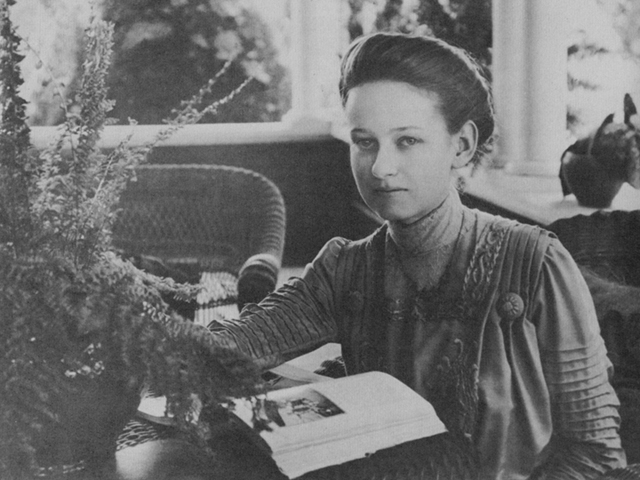
Miss Gladys H. Ratekin (1888-1952). Image source: Pflueger, D. H. (1964).1
Unfortunately, as far as I've been able to determine, the library no longer has this material. Furthermore, no documentation apparently survives which details Miss Ratekin's own historical work from 1936 until 1952, when she herself died. All we are told is that her mother–Mrs. Clara D. Ratekin–subsequently turned over her daughter's notes to Donald Pflueger and endowed him with a trust fund to write the book on Covina history that her wheelchair-bound daughter was unable to complete.1
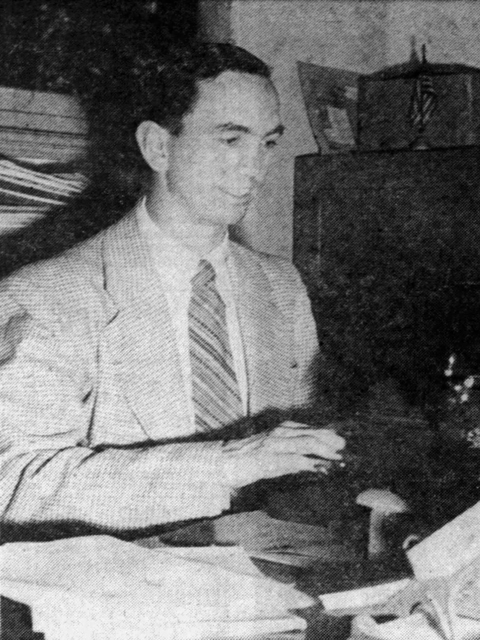
Donald Howard Pflueger (1923-1994). Image source: Pomona Progress-Bulletin, September 18, 1953.25
Prof. Pflueger worked on his Covina project off and on for 12 years, and when his book was finally published in 1964, he acknowledged only Gladys Ratekin as a Covinan who had devoted years of her life to researching the people, places and events relevant to the city's history:
Miscellaneous notes constituted the bulk of the Ratekin Papers. Only one completed chapter of Gladys' projected history was found; [...] Gladys left no outline, but it is hoped that the contents and organization of this book would be along the lines of her thinking. In our conversation it became evident that she was deeply interested in every facet of the community's development–cultural, social, religious, ecomonic, governmental, and educational.1
But we now know Pflueger was aware of Mrs. Pardon Head's previous work on exactly those same topics, so why didn't he acknowledge her in his book, as well? Given how long and hard she worked to document Covina's past, leaving any mention of her out of that history seems unjust to me. It is my hope that this article will serve to set things right and give Mrs. Head the credit she was due.
As a postscript, I can't help but wonder... had a certain trailer hitch not come loose one summer night long ago in rural central Wyoming, modern-day students of Covina history like myself might today be on a different timeline in which Donald Pflueger never wrote his book, and Gladys Ratekin thanked instead in the acknowledgements in Harriett R. Head's definitive History of the Covina Valley.
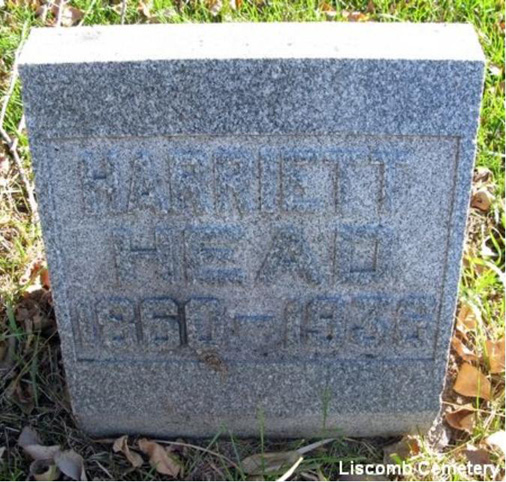
Source: Find a Grave.26 Photo by Larry Head.

References:
1 Pflueger, D. H. 1964. Covina: Sunflowers, Citrus, Subdivisions. Castle Press, Pasadena, California, 372pp.
2 Covina Citizen, June 7, 1935, p.4.
3 Covina Argus-Citizen, September 26, 1952, p.10.
4 Covina Citizen, February 26, 1931, p.9.
5 Covina Argus, February 12, 1926, p.2.
6 Covina Argus, October 1, 1926, p.4.
7 Covina Argus, November 19, 1926, p.1.
8 Covina Argus, January 31, 1930, p.2.
9 Covina Citizen, May 28, 1931, p.5.
10 Covina Citizen, June 11, 1931, p.7.
11 Covina Citizen, October 29, 1931, p.3.
12 Covina Citizen, November 26, 1931, p.3.
13 Covina Citizen, March 10, 1932, p.7.
14 Covina Citizen, May 19, 1932, p.3.
15 Covina Citizen, April 28, 1933, p.7.
16 Covina Citizen, January 19, 1934, p.15.
17 Covina Argus, May 28, 1930, p.8.
18 Covina Argus, November 7, 1930, p.11.
19 Covina Citizen, June 4, 1931, p.3.
20 Covina Citizen, January 28, 1932, p.7.
21 Pomona Progress-Bulletin, September 10, 1936, p.5.
22 Covina Argus, October 31, 1930, p.3.
23 Covina Citizen, January 29, 1931, p.8.
24 Covina Citizen, May 28, 1931, p.8.
25 Pomona Progress-Bulletin, September 18, 1953, p.3.
26 Find a Grave memorial for Harriett Russell Head.
Source of all news clippings: Newspapers.com.
No comments:
Post a Comment
To post a comment, you must login to this page with the Google Chrome web browser. That is the only way that works now.